Chefs share recipes in 7 ways to use up leftover CNY snacks
In a week or so, the last platter of yusheng will have been tossed and the last guest bade farewell. Many families will find themselves with a fridge full of mandarin oranges and strips of bak kwa.
Suddenly, these no longer taste as good in an empty house. But before you throw them away or leave them to fester in the fridge, consider incorporating them into your everyday meals.
You will be doing the environment a massive favour. This season, after all, is notorious for the food waste it generates – as much as 30 per cent more than usual, estimate some researchers.
“Cultural pressure to symbolise abundance and practices like overbuying during Chinese New Year significantly contribute to food waste,” says Mrs Jaspreet Kaur, 35, head of marketing, communications and sustainability at food service company Sodexo Malaysia-Singapore. “Reducing food waste over this period is a matter of thoughtful planning, mindful storage, and creative reuse of leftovers.”
Here are seven recipes contributed by chefs to give your festive leftovers a new lease of life.
Bak kwa scones
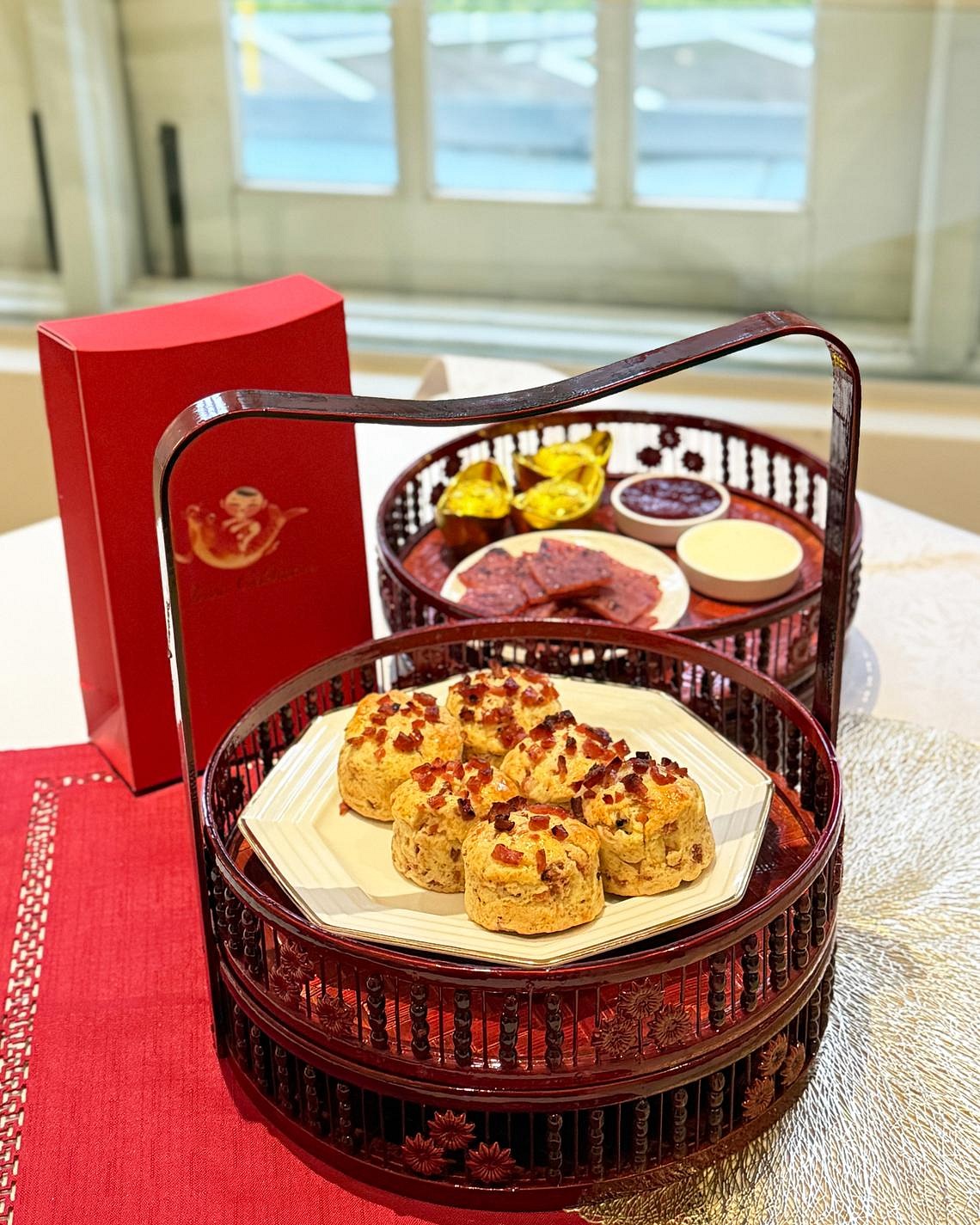
These bak kwa scones by Goodwood Park Hotel executive pastry chef Joe Tan, 55, are inspired by the signature offering at the hotel’s afternoon tea buffet.
“This fusion combines the comforting British scone with the savoury flavour of bak kwa, bridging cultures and offering a fresh take on tradition,” he says.
The scones should turn out soft and crumbly, with a buttery richness complemented by the bak kwa’s smoky fragrance.
Ingredients
- 250g cake flour
- 15g baking powder
- 63g butter, softened
- 46g sugar
- 2g salt
- 53g milk
- 50g buttermilk
- 2 eggs (one beaten, for egg wash)
- 200g bak kwa, chopped
Method
1. Create a flour mixture by mixing the cake flour, baking powder, softened butter, sugar and salt together until combined.
2. Separately, mix the milk, buttermilk and one egg together. Once mixed, add to the flour mixture to combine.
3. Add 150g of chopped bak kwa to the combined mixture.
4. Use a rolling pin to flatten the dough to a thickness of about 3cm.
5. Pre-heat the oven to 220 deg C.
6. Use a round cutter 5 to 6cm in diameter to portion out the scones.
7. Place on a baking tray and apply a layer of egg wash on top of the scones. Distribute the remaining 50g of chopped bak kwa on top of each scone.
8. Bake for 15 to 20 minutes until golden brown.
9. Serve with clotted cream and jam.
Makes 10 scones
Bak kwa pasta
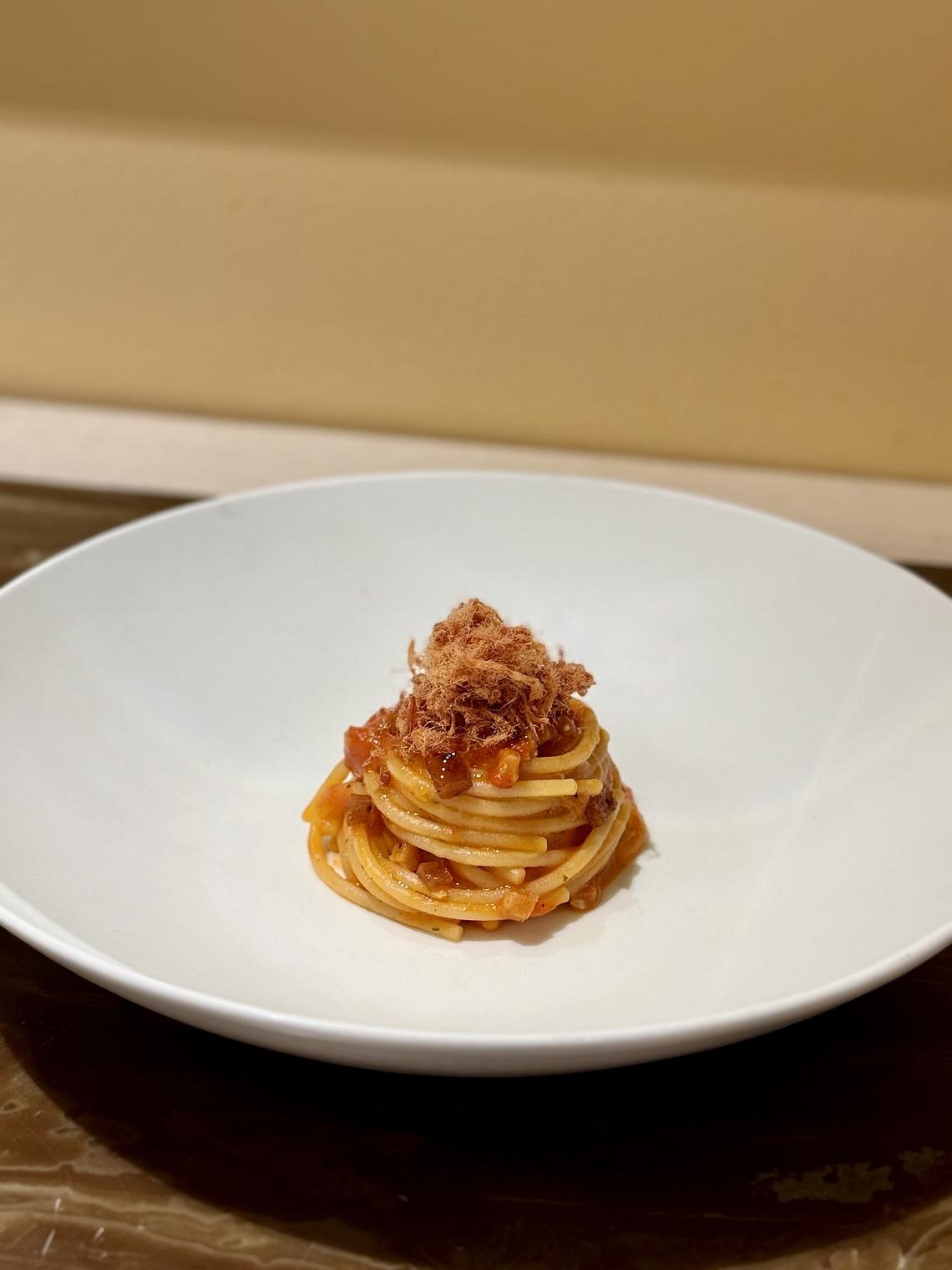
Alternatively, turn your bak kwa into pasta. Denis Lucchi, head chef at one-Michelin-starred Italian restaurant Buona Terra, has put together a recipe that combines it with tomatoes and cheese.
“I chose bak kwa because it has similarities with cured pork from Italy, like guanciale, which is often cooked with pasta,” says the 43-year-old Italian, adding that bak kwa was the first snack he had for Chinese New Year.
“I also thought the smokiness would add an extra touch to the pasta sauce, while the sweetness would complement the acidity of local tomatoes.”
He uses dry spaghetti and cooks it for 12 minutes to achieve an al dente texture, but you can use any pasta you have in the pantry.
Ingredients
- 150g dried pasta
- Half clove of garlic, chopped
- 1 Tbs olive oil
- 2 large tomatoes, peeled and chopped
- 2 Tbs tomato sauce (optional)
- 1 slice bak kwa, chopped
- Chilli oil or chilli padi (optional)
- 2 Tbs Parmesan cheese, grated
- A bit of parsley, for garnish
- A bit of pork floss, for garnish
Method
1. Cook the pasta of your choice in boiling water until al dente. Follow the instructions on the packet.
2. About one minute before the pasta is fully cooked, drain it, keeping the pasta water for the sauce.
3. At the same time, saute chopped garlic in the olive oil.
4. Add chopped and peeled large tomatoes, saute until the juices are released.
5. Add pasta water and tomato sauce. Then add the chopped bak kwa to the sauce for two to three minutes.
6. For extra heat, you can drizzle chilli oil or add chilli padi to the sauce.
7. Toss the pasta in the sauce for a couple of minutes, allowing the starch to be released.
8. Add grated Parmesan cheese and a drizzle of olive oil.
9. Plate the pasta and garnish with some chopped parsley.
10. Finish with your preferred amount of pork floss, sprinkled over the spaghetti.
Serves two
Pineapple tart pizza

Jenna Ding, the pizzaiolo behind popular home-based omakase experience Wala Pizza, is no stranger to wacky flavours. Her recent experiments include a tonkotsu wagyu ramen pizza, as well as a French onion soup flavour with truffle liver pate.
For Chinese New Year, she has incorporated pineapple tarts into her signature dish, which also includes a lap cheong-inspired crumbled sausage made with minced pork and bacon. But you can skip this step and use leftover lap cheong for a more straightforward option.
“This festive flavour has all the right punches – fruity, spiced, rummy, savoury, juicy and umami. All well-balanced, with pineapple tarts adding that final dimension,” says the self-taught pizza chef, who is in her 30s.
Her dough-making process is tedious, so she suggests using store-bought dough or a simple dough recipe online.
Ingredients
- 1 whole pineapple, sliced into wedges
- 2 Tbs honey
- 2 Tbs butter
- 2 Tbs rum
- 2 Tbs coconut cream
- 200 to 250g dough base
- 80g mozzarella
- Handful fresh pea sprouts
- Handful vintage cheddar, crumbled
- 6 pineapple tarts
- Handful chilli threads, for garnish (optional)
- Handful popped buckwheat, for garnish (optional)
- Drizzle of extra virgin olive oil or chilli oil (optional)
- Black pepper, for garnish
For the pineapple emulsion
- Half the pineapple (from above)
- 1 Tbs cream cheese
- 1 Tbs coconut cream
- 1 Tbs rum
- Drizzle of honey
- Pinch of salt and pepper
For the lap cheong-inspired sausage
- 50g smoked bacon bits
- 100g minced pork
- Pinch of chilli flakes
- Pinch of white pepper
- ½ Tbs roasted Sichuan peppercorns
- 1 tsp rice wine
Method
1. Coat the pineapple in the honey, butter, rum and coconut cream. Roast for 10 to 15 minutes at 180 deg C.
2. Slice into small chunks. Save half for toppings and use the other half to make the pineapple emulsion.
3. Make the pineapple emulsion by blending half the roasted pineapple chunks with the cream cheese, coconut cream, rum, drizzle of honey, and a pinch of salt and pepper till the mixture reaches a creamy light yellow consistency.
4. Make lap cheong-inspired sausage by marinating smoked bacon bits and minced pork with chilli flakes, white pepper, toasted Sichuan peppercorns and rice wine and grill for three to five minutes.
5. Stretch out your dough to 25.5 to 28cm in diameter and spread the pineapple emulsion over it, covering the entire base except the rim.
6. Scatter the mozzarella, pea sprouts and remaining roasted pineapple chunks over the pizza. Crumble the sausage over the base and add the vintage cheddar.
7. Bake pizza at 500 deg C for about 60 seconds or 250 deg C for 10 to 15 minutes.
8. After baking, top with the pineapple tarts, chilli threads and popped buckwheat. Add a drizzle of extra virgin olive oil or chilli oil and a fresh crack of black pepper.
9. Slice and serve.
Makes one pizza
Glutinous rice with preserved sausages
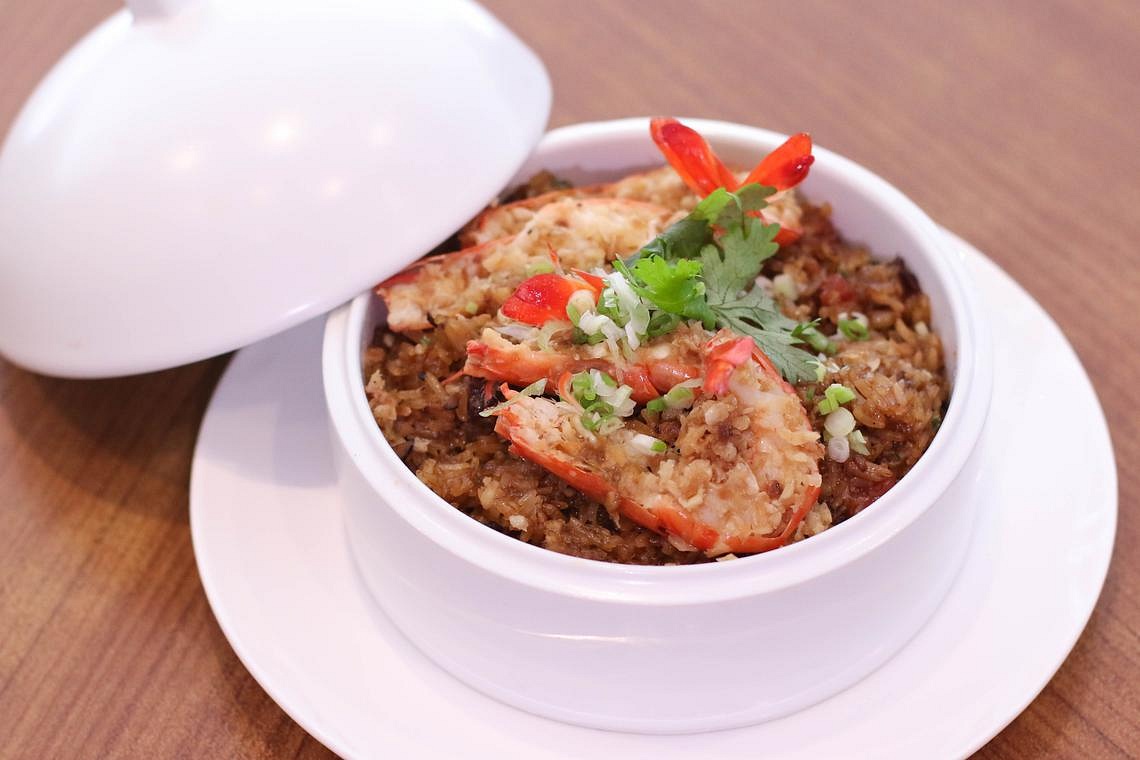
This single-portion dish uses up your leftover sausages and glutinous rice. It is contributed by Hua Ting master chef Lap Fai, who has added prawns for an extra dose of sweetness.
The recipe also calls for preserved meats. Any type of meat can be used.
“The key is ensuring that the meat is well-preserved and has absorbed the flavours typically associated with such dishes. It’s important to choose preserved meats that complement the flavours of the other ingredients and the overall dish,” says the 60-year-old chef.
Ingredients
- 60g glutinous rice
- 1 tsp oyster sauce
- 1 tsp light soya sauce
- 1 Tbs dark soya sauce
- 30g preserved meat, diced
- 30g preserved Chinese sausage, diced
- 30g preserved liver sausage, diced
- 30g dried shrimp
- 50g garlic, minced
- 2 Tbs vegetable oil
- 70g prawns
- 20g spring onion, chopped
- 20g coriander
Method
1. Soak glutinous rice for two hours. Mix it with the oyster sauce, light soya sauce and dark soya sauce, and steam in a steamer for 30 minutes. Set aside to cool down.
2. Steam the preserved meat and sausages for 20 minutes. Soak the dried shrimp for 20 minutes.
3. Stir-fry the garlic in oil till golden brown. Set aside.
4. Stir-fry assorted preserved meat and dried shrimp together in oil till fragrant. Add glutinous rice and stir well, then place into a bamboo basket.
5. Cut the prawns in half and place on top of the glutinous rice. Sprinkle the garlic on top. Steam again for another 10 minutes.
6. Sprinkle chopped spring onion and coriander on the dish and serve.
Serves one
Crispy spring rolls with nian gao
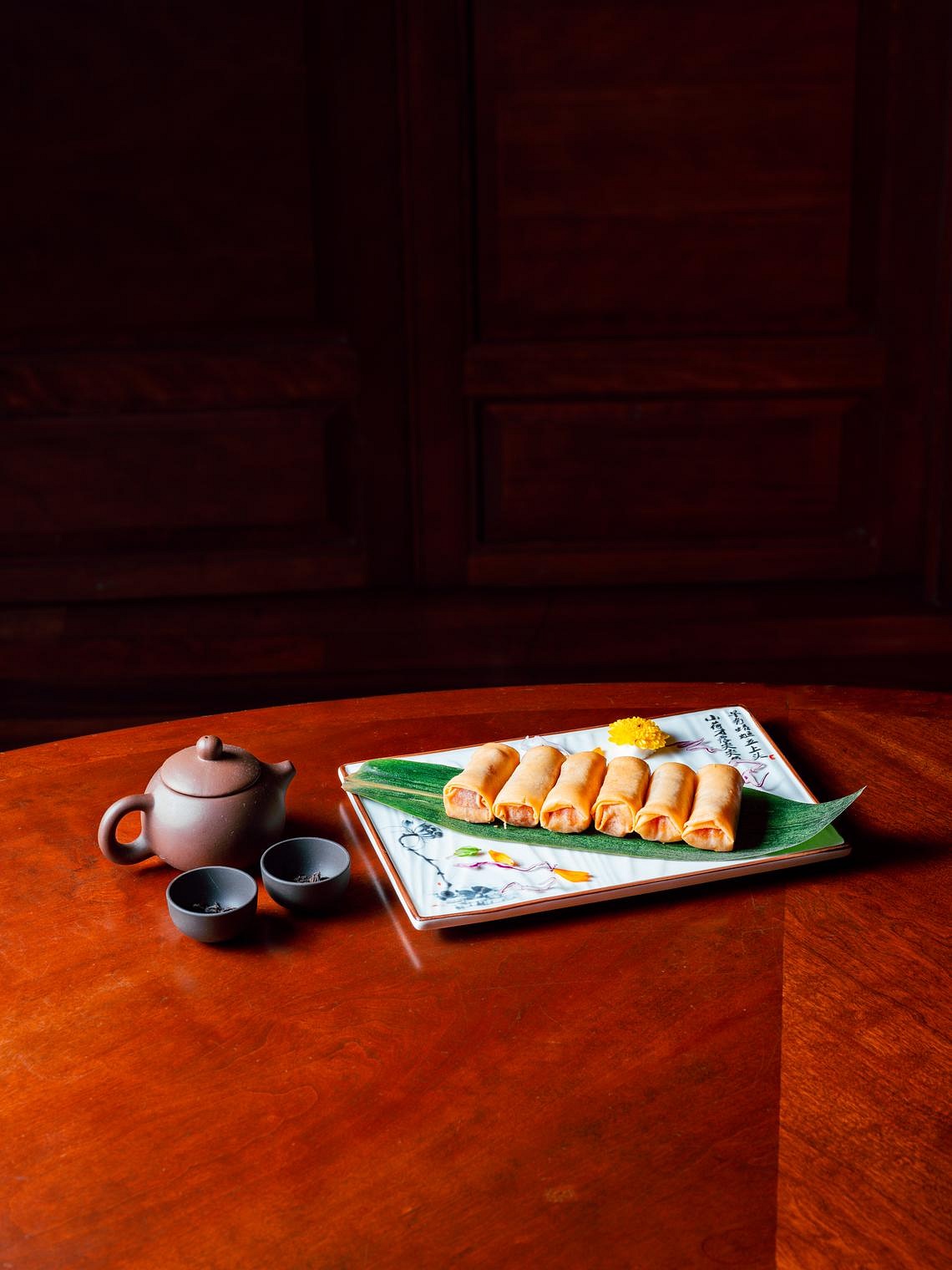
Because nian gao symbolises prosperity and is a homonym for “higher year”, it is traditionally eaten at Chinese New Year for good luck.
But that also means the sticky rice cake ends up being one of the most common post-new year leftovers. Unlike mochi and muah chee, it has not quite made the transition from festive treat to year-round dessert.
Tien Court dim sum chef Liew Kok Ming, 51, wants to change that impression by turning it into a spring roll, jazzed up with sweet potato and taro.
“The goal is balance. Each bite should be crisp on the outside, with a harmonious blend of chewy and soft textures inside, accompanied by a comforting sweetness from the earthy richness of the sweet potato and taro that isn’t overly cloying,” he says.
Pumpkin can also be used instead of sweet potato for a softer texture and hint of natural sweetness. If you have a sweet tooth, dust on some powdered sugar or add a light drizzle of honey.
Ingredients
- 120g nian gao
- 120g sweet potato, peeled
- 120g taro, peeled
- 6 spring roll wrappers
- 1 egg white
- 460ml vegetable oil
Method
1. Cut the nian gao into small, rectangular slices of about 20g each.
2. Cut the sweet potato and taro into small, rectangular slices of about 20g each.
3. Steam the sweet potato and taro strips for eight to 10 minutes, or until fork-tender but not mushy.
4. Lay a spring roll wrapper flat, then top with the steamed sweet potato, taro and the sticky rice cake.
5. Roll the spring roll into shape, sealing the edges with a little egg white.
6. Heat oil to 180 deg C and fry the spring rolls for about five minutes until crispy.
7. Serve warm.
Makes six spring rolls
Mandarin orange marmalade
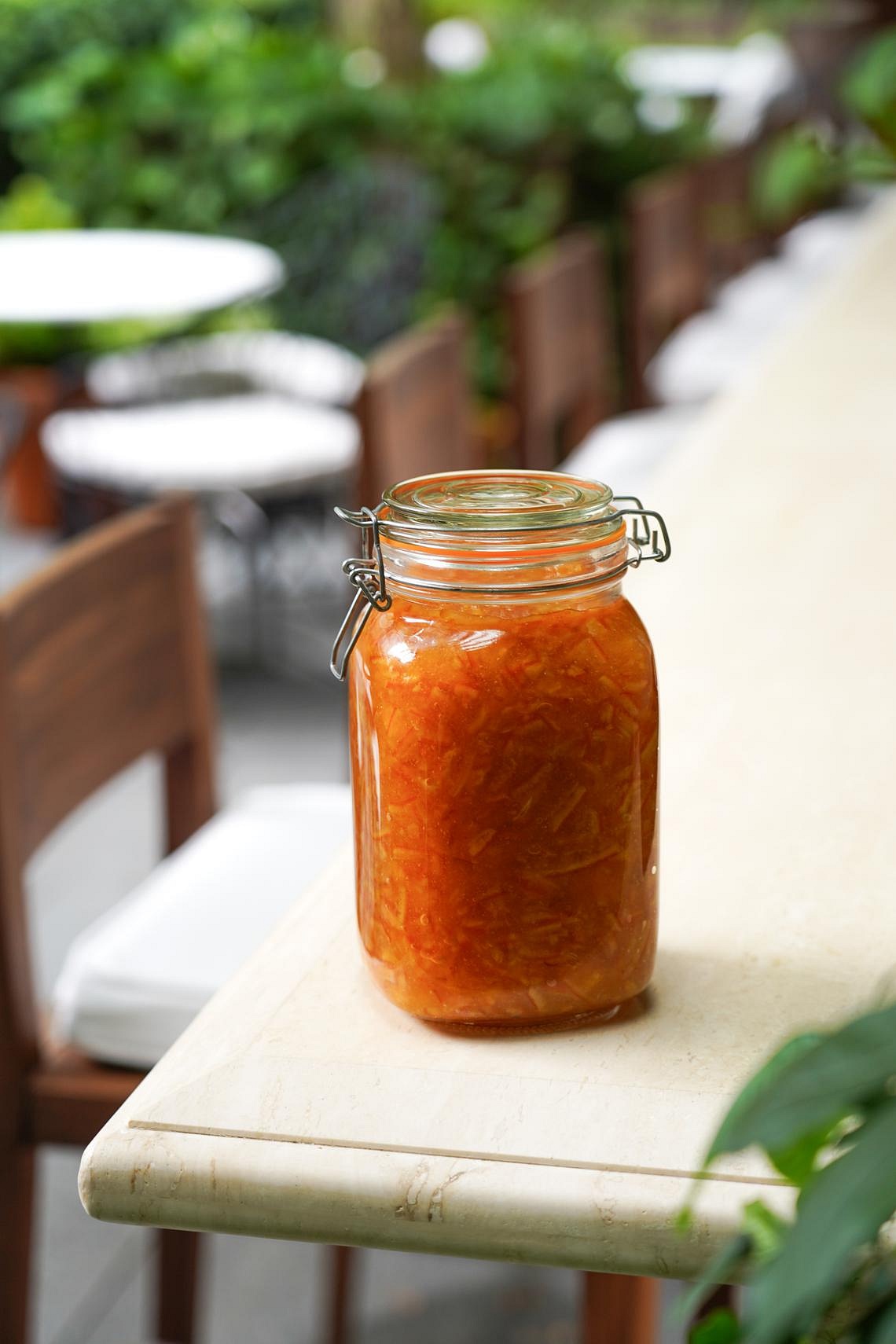
Mandarin oranges keep for around two weeks in the fridge. If you want to make them last even longer, why not turn them into marmalade?
This marmalade by Alex Chong, 43, executive pastry chef at The Singapore Edition, can be stored in the refrigerator for up to a year. Once opened, it should be consumed within a month.
The recipe fills up to 10 200ml jars, though it can be tweaked depending on how many oranges you have left. Tart and sweet, it pairs well with bread, pastries, cheese, crepes, tarts and some meat dishes.
Though the season of giving may be over, this homemade jam comes in handy if you are in need of a gift with a personal touch.
Ingredients
- 1kg mandarin oranges
- Pinch of salt
- 500g sugar
- 55g fresh lemon juice
- 500ml water
Method
1. Peel the mandarins and remove as much pith as possible. Separate the segments and remove seeds. Cut the segments into small pieces or blend them slightly for a smoother marmalade.
2. Slice the peel into thin strips. Boil the strips in water with a pinch of salt for five minutes to soften and remove the bitterness. Drain and set aside.
3. In a large cooking pot, combine the mandarin pieces, softened peel, sugar, lemon juice and water. Heat on medium, stirring gently until the sugar dissolves completely.
4. Bring the mixture to a boil, then reduce the heat to a simmer. Let it cook for 40 to 50 minutes, stirring occasionally to prevent sticking, until the mixture thickens.
5. To check if the marmalade is ready, place a small amount on a cold plate and let it cool for a minute. Push it with your finger; if it wrinkles, it is done. If not, continue cooking for a few more minutes and test again.
6. While the marmalade cooks, sterilise your jars and lids by washing them in hot soapy water, rinsing thoroughly and placing them in a 120 deg C oven for 10 minutes.
7. Pour the hot marmalade into the sterilised jars, leaving about 1cm of headspace. Seal immediately with sterilised lids.
8. Allow the jars to cool completely at room temperature before storing.
Makes up to 2 litres of jam
Golden chicken with mandarin oranges
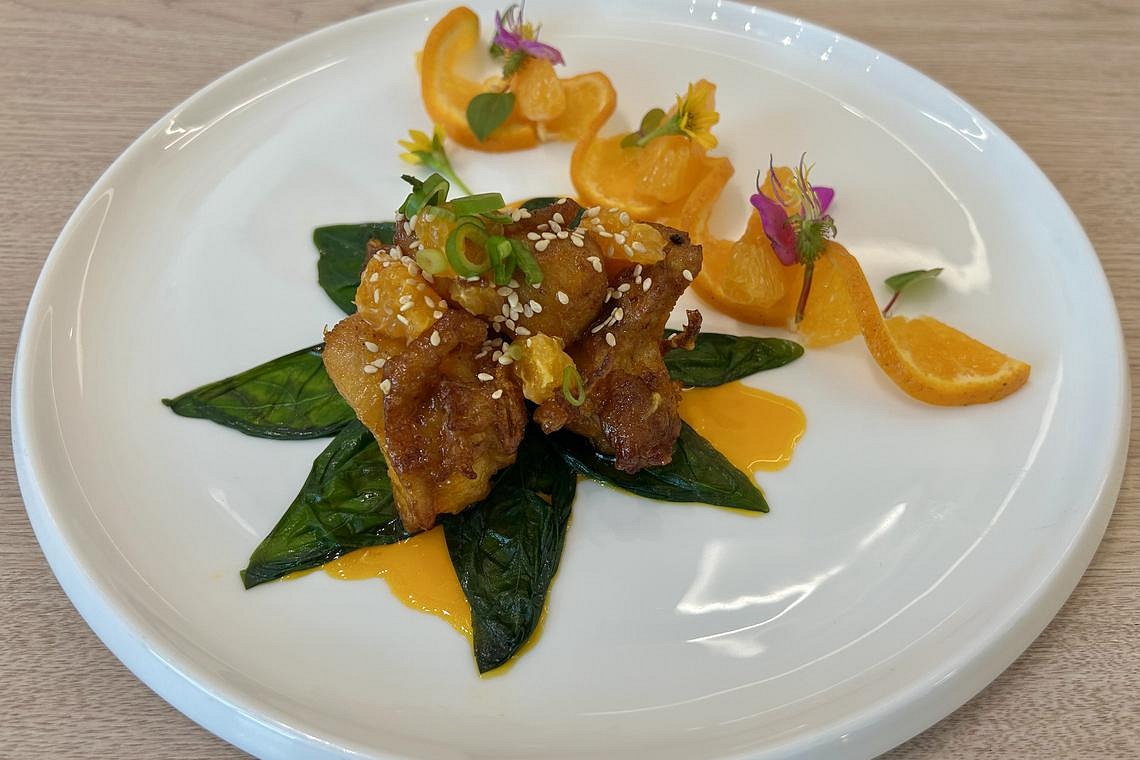
Your leftover oranges can also be turned into a savoury dish. This recipe by Sodexo senior head chef Jack Lee, 42, makes use of the peel as well.
It is part of a zero-waste recipe book that the food service company is launching on its blog this festive season.
“The cookbook features zero-waste recipes created and tested by our chefs, showing how easy it is to adopt zero-waste practices. Nutritional tips encourage the use of often-discarded parts of food, like watermelon rinds, which offer health benefits while reducing waste,” says Sodexo’s Mrs Kaur.
Mandarin oranges offer their fair share of health perks. Packed with vitamin C, they help boost collagen production, resulting in healthier skin and bones.
Ingredients
- 2 mandarin oranges
- 50ml water
- 100g sugar
- 50g maple syrup
- 500g boneless chicken leg
- 6g five spice powder
- 8g fine salt
- 50g tapioca flour
- 200g cooking oil
- 2g roasted sesame seeds
- 1 stalk cilantro, finely chopped
- 1 red chilli, finely chopped
Method
1. Peel the mandarin oranges and wash the peel thoroughly. Set aside the orange flesh in the fridge.
2. Place the peel on a baking tray lined with baking paper. Air-dry under the sun for three days, flipping the peel daily. If not completely dry after three days, continue air-drying, flipping every two days.
3. Remove the seeds from the orange flesh. Blend the flesh with water to extract the juice.
4. Simmer the juice in a pot over low heat for 20 minutes, or until the water level significantly reduces. Add sugar, stir till dissolved and let cool. Stir in the maple syrup and set aside the sauce.
5. Cut boneless chicken legs into finger-size pieces and pat dry.
6. Soak the dried mandarin orange peel in hot water until softened. Cut into julienned strips.
7. Mix the five spice powder, salt and tapioca flour together. Coat the chicken evenly with the spice mix, rubbing it into the meat.
8. Deep-fry the spiced chicken in 180 deg C cooking oil until golden brown and crispy. Drain excess oil.
9. Toss the fried chicken with the mandarin orange sauce.
10. Garnish with sesame seeds, cilantro and red chilli, and serve.
Serves three to five people
Get The New Paper on your phone with the free TNP app. Download from the Apple App Store or Google Play Store now


